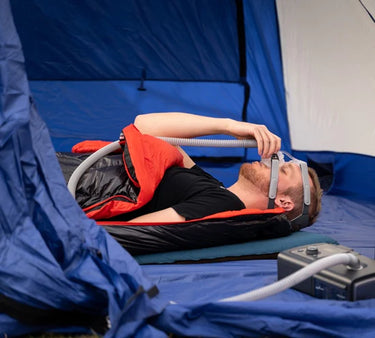Micro-CPAP: A New Revolution or Just Another Scam?
Obstructive sleep apnea (OSA) is a common problem where your throat muscles relax during sleep, making it hard for you to breathe properly. One common treatment for this is Continuous Positive Airway Pressure (CPAP) therapy. CPAP machines use a mask or nosepiece connected to a tube to blow air into your airway, keeping it open so you can breathe normally. CPAP machines are very effective, but they can be bulky, uncomfortable, and noisy. Many people have been hoping for a more convenient solution.
Recently, some companies have been promising a small, easy-to-use “micro-CPAP” device. These devices claim to provide the same benefits as a CPAP machine but in a much smaller, more portable design. But is this a breakthrough, or is it just another scam taking advantage of people’s struggles with sleep apnea?
The Dream of Micro-CPAP
Micro-CPAP devices promise to make treating sleep apnea easier. They claim to be small, disposable, and inexpensive. The idea is to create a device that you can insert into your nose, eliminating the need for bulky masks and tubes. Some of these devices even promise to provide enough airflow pressure to treat sleep apnea while being small and cheap.
It sounds almost too good to be true, right? Well, it might be.
The Problem with Micro Blowers
The key technology in these micro-CPAP devices is micro blowers—small fans that generate airflow. Since they are smaller, they can fit inside the device, allowing it to be worn inside the nose.
But there’s a problem. While micro blowers do exist, they aren’t powerful enough to generate the airflow needed to treat sleep apnea. For example, a typical CPAP machine needs to provide around 10 cmH2O of pressure and 30 liters of air per minute. The micro blowers available today can only produce 1 liter per minute. Even if you used several of these small blowers, they still wouldn’t create enough airflow. And the cost of these blowers? They are already $19 each, but these devices are being sold as a disposable product costing only $3 per use. This doesn’t add up.
The Battery Problem
Another big issue is battery power. CPAP machines need a lot of power to keep the air flowing. To run these machines, you need a decent-sized battery pack, and those packs are heavy but able to last through the night.
However, the micro-CPAP devices claim they can use small, disposable batteries to run for several hours. So how do they manage that? The short answer is: they don’t. To generate the airflow and pressure needed, the device would require a much larger battery than what’s promised, especially given its small design. These batteries would need to weigh at least 8 ounces, just for the airflow generation, without even considering the power needed for electronics.
Humidity Control Issues
Another problem with these micro-CPAP devices is that they don’t include humidity control. A regular CPAP machine uses water to keep the air moist because dry air can irritate your nose and throat. Without this feature, breathing dry air all night could cause discomfort or even damage to your nasal passages. Some micro-CPAP devices claim that your nose can handle dry air, but anyone with sleep apnea knows how important it is to have moisture in the air.
The Price Problem
One of the most surprising things about these micro-CPAP devices is their claimed cost: only $3 per use. This makes them seem like a perfect replacement for traditional CPAP machines. But when you look at the actual cost of the parts, it doesn’t make sense. Just one micro blower costs $19, and that doesn’t even include the battery, the housing, or the electronics. To make a medical-grade product with all these features and still sell it for $3 per use seems impossible.
Disappearing Companies and Broken Promises
As with many crowdfunding projects, these micro-CPAP devices were marketed as revolutionary innovations. Supporters were told they were helping to fund a new, life-changing product. But years later, the promised devices have still not appeared, and the companies behind them seem to have disappeared.
Some backers have shared their experiences online, saying they haven’t received any updates or responses from the company. In one case, a promotional video showing the technology didn’t even work. The company’s website has no contact information, and emails sent to them were ignored. This lack of transparency is a big warning sign for anyone thinking about supporting these products.
Can Innovation Solve These Problems?
The required technology does exist, but it’s not there yet. Battery technology, airflow generation, and humidity control need to improve before these micro-CPAP devices can become a reality. These technologies might eventually make it possible, but that time isn’t here yet. The issue isn’t that these devices can’t be made; it’s that the companies promised something that wasn’t ready.
These companies sold an untested product and used hopeful customers as their testing ground. It’s not only risky but also unethical to promise a product before it’s fully developed.
A Better Option for CPAP Users
If you need a CPAP machine, one great alternative is using a CPAP battery from Easylonger. Instead of relying on unproven, small devices, you can use a battery-operated CPAP machine that works reliably both indoors and outdoors. Easylonger’s travel CPAP with battery is perfect for camping, business trips, or other situations where you need to use a battery CPAP. It ensures that you can get a good night’s sleep without worrying about power issues, no matter where you are.
For people with sleep apnea, the best advice is to stick with proven, effective solutions. Battery-operated CPAP machines and CPAP batteries provide the reliability and comfort that these micro-CPAP devices just can’t offer. And always remember to talk to your doctor about the best treatment for you.















